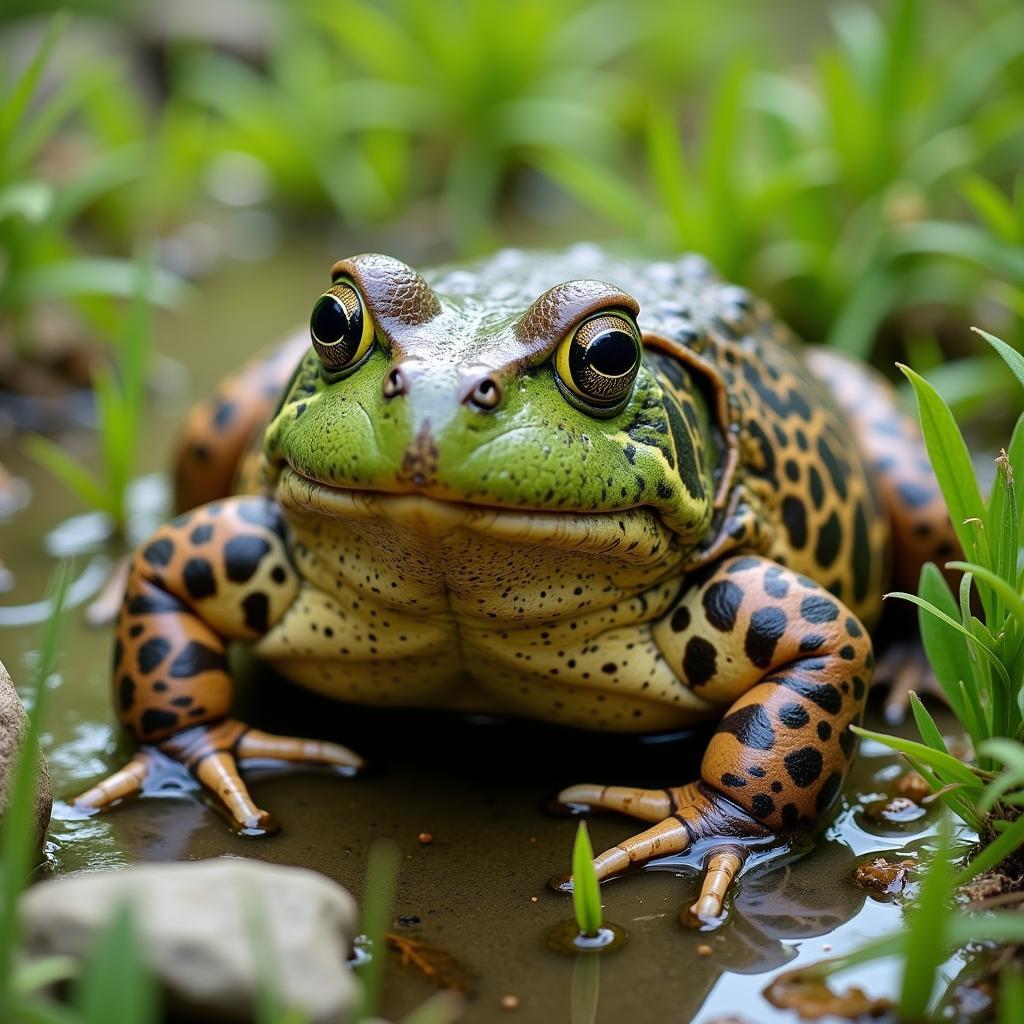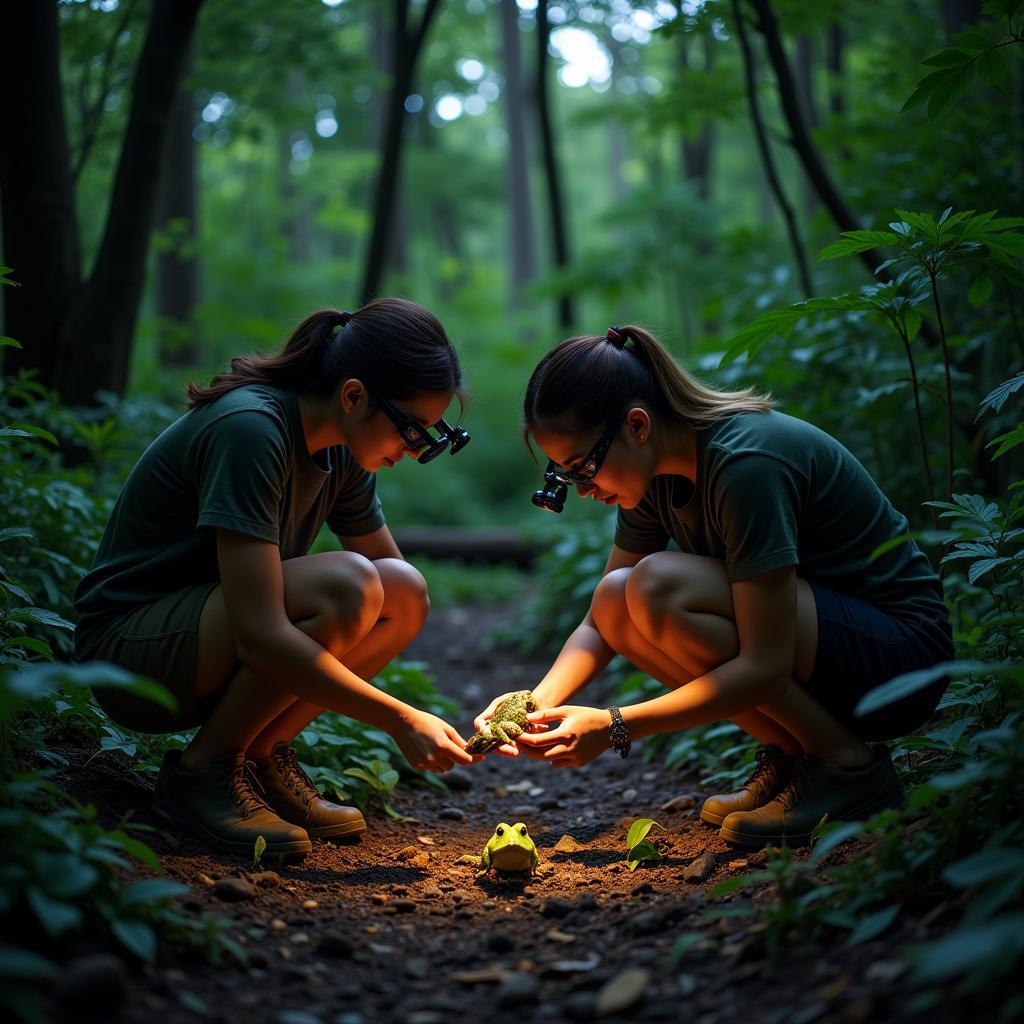Exploring the Fascinating World of African Frogs
African frogs represent a diverse and captivating group of amphibians found throughout the continent’s varied landscapes. From the rainforests of Central Africa to the savannas of the south, these creatures have adapted to a wide range of habitats and exhibit an astonishing array of colors, patterns, and behaviors.
 African bullfrog camouflaged in grassland
African bullfrog camouflaged in grassland
A Symphony of Sounds: The Calls of African Frogs
One of the most remarkable aspects of African frogs is their vocal repertoire. Each species possesses a unique call, ranging from high-pitched whistles to deep croaks, used for attracting mates, defending territories, and communicating with other individuals. During the breeding season, the air resonates with a symphony of frog calls, creating a mesmerizing auditory experience.
For instance, the aptly named African bullfrog, known for its impressive size and voracious appetite, emits a deep, resonant call that can be heard from considerable distances. In contrast, the painted reed frog, a small, vibrantly colored species found in East Africa, produces a series of high-pitched clicks.
Adaptations for Survival: From Camouflage to Toxicity
African frogs have evolved an array of adaptations to survive in their respective environments. Many species, such as the African tree frog, possess adhesive toe pads that allow them to cling to smooth surfaces, enabling them to navigate the arboreal world with ease. Others, like the rain frog, have developed burrowing adaptations, spending the dry season underground and emerging only when the rains return.
In addition to physical adaptations, many African frogs employ chemical defenses to deter predators. The phantasmal poison frog, for example, secretes toxins through its skin that are potent enough to deter even the most determined attacker. This vibrant species serves as a warning to predators with its bright coloration, a phenomenon known as aposematism.
African Frogs: An Integral Part of the Ecosystem
African frogs play a vital role in maintaining healthy ecosystems. As both predators and prey, they help regulate populations of insects and other invertebrates, while also serving as a food source for snakes, birds, and other animals. Furthermore, their sensitive skin makes them important indicators of environmental health, providing insights into the overall well-being of their habitats.
The Future of African Frogs: Conservation Challenges and Opportunities
Despite their ecological importance, many African frog species face growing threats from habitat loss, climate change, pollution, and disease. Conservation efforts are underway to protect these fascinating creatures, focusing on habitat restoration, captive breeding programs, and public awareness campaigns.
 Researchers surveying frog populations in a lush rainforest
Researchers surveying frog populations in a lush rainforest
By understanding the unique adaptations, ecological roles, and conservation challenges facing African frogs, we can better appreciate the importance of preserving these remarkable creatures for generations to come.
Frequently Asked Questions about African Frogs
1. What is the largest frog species in Africa?
The African goliath frog (Conraua goliath) holds the title of the largest frog species in Africa, and indeed the world, reaching lengths of up to 13 inches and weighing over 7 pounds.
2. Are all African frogs poisonous?
No, not all African frogs are poisonous. While some species, like the phantasmal poison frog, possess potent toxins, the majority of African frogs are harmless to humans.
3. What do African frogs eat?
Most African frogs are insectivores, feeding on a diet of insects, spiders, and other small invertebrates. However, larger species, such as the African bullfrog, are known to consume small mammals, birds, and even other frogs.
4. Where can I see African frogs in the wild?
African frogs can be found in a variety of habitats across the continent, from rainforests and wetlands to savannas and grasslands. National parks and reserves offer excellent opportunities to observe these fascinating creatures in their natural environments.
5. How can I help conserve African frogs?
Supporting conservation organizations working to protect African frogs and their habitats is crucial. Additionally, reducing your environmental footprint by conserving water, reducing pollution, and supporting sustainable practices can contribute to the long-term survival of these amphibians.
Need assistance? Contact us at Phone Number: +255768904061, Email: kaka.mag@gmail.com or visit us at Mbarali DC Mawindi, Kangaga, Tanzania. Our customer service team is available 24/7.

